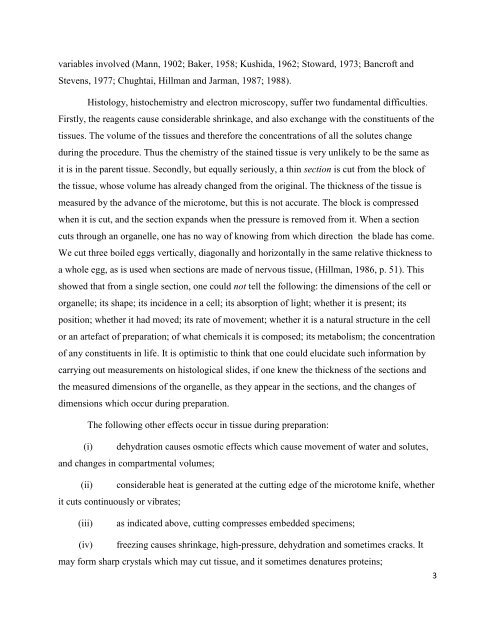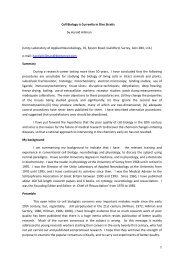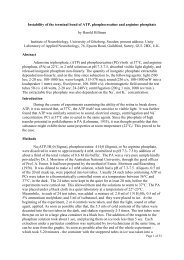download PDF version - Dr Harold Hillman
download PDF version - Dr Harold Hillman
download PDF version - Dr Harold Hillman
- No tags were found...
Create successful ePaper yourself
Turn your PDF publications into a flip-book with our unique Google optimized e-Paper software.
variables involved (Mann, 1902; Baker, 1958; Kushida, 1962; Stoward, 1973; Bancroft andStevens, 1977; Chughtai, <strong>Hillman</strong> and Jarman, 1987; 1988).Histology, histochemistry and electron microscopy, suffer two fundamental difficulties.Firstly, the reagents cause considerable shrinkage, and also exchange with the constituents of thetissues. The volume of the tissues and therefore the concentrations of all the solutes changeduring the procedure. Thus the chemistry of the stained tissue is very unlikely to be the same asit is in the parent tissue. Secondly, but equally seriously, a thin section is cut from the block ofthe tissue, whose volume has already changed from the original. The thickness of the tissue ismeasured by the advance of the microtome, but this is not accurate. The block is compressedwhen it is cut, and the section expands when the pressure is removed from it. When a sectioncuts through an organelle, one has no way of knowing from which direction the blade has come.We cut three boiled eggs vertically, diagonally and horizontally in the same relative thickness toa whole egg, as is used when sections are made of nervous tissue, (<strong>Hillman</strong>, 1986, p. 51). Thisshowed that from a single section, one could not tell the following: the dimensions of the cell ororganelle; its shape; its incidence in a cell; its absorption of light; whether it is present; itsposition; whether it had moved; its rate of movement; whether it is a natural structure in the cellor an artefact of preparation; of what chemicals it is composed; its metabolism; the concentrationof any constituents in life. It is optimistic to think that one could elucidate such information bycarrying out measurements on histological slides, if one knew the thickness of the sections andthe measured dimensions of the organelle, as they appear in the sections, and the changes ofdimensions which occur during preparation.The following other effects occur in tissue during preparation:(i) dehydration causes osmotic effects which cause movement of water and solutes,and changes in compartmental volumes;(ii) considerable heat is generated at the cutting edge of the microtome knife, whetherit cuts continuously or vibrates;(iii)as indicated above, cutting compresses embedded specimens;(iv)freezing causes shrinkage, high-pressure, dehydration and sometimes cracks. Itmay form sharp crystals which may cut tissue, and it sometimes denatures proteins;3




